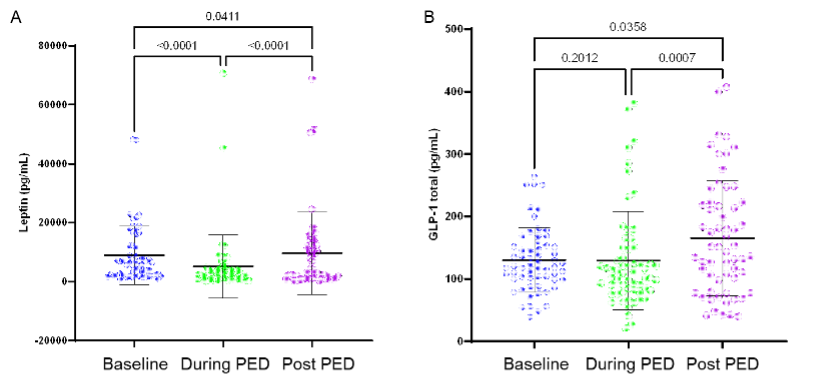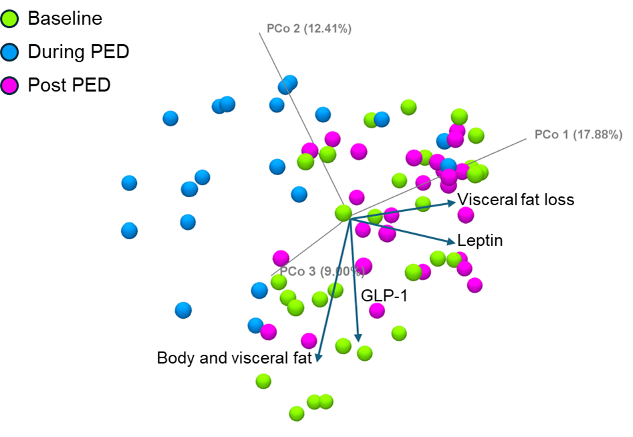Tuesday Poster Session
Category: Diet, Nutrition, and Obesity
P4835 - Visceral Fat Reduction via Palatable Elemental Diet Is Linked to Microbial and Hormonal Shifts in Adults
Tuesday, October 28, 2025
10:30 AM - 4:00 PM PDT
Location: Exhibit Hall

Gabriela Leite, PhD (she/her/hers)
Cedars-Sinai Medical Center
West Hollywood, CA
Presenting Author(s)
Gabriela Leite, PhD1, Juliana Germano, PhD1, Nicha Wongjarupong, MD2, Bianca Chang, MD3, Mark Pimentel, MD, FACG2, Ruchi Mathur, MD1, Krystyna Houser, 4, Daniel Brimberry, PhD2, Mohamad Rashid, MD2, Ava Hosseini, MPH1, Sepideh Mehravar, MD2, Maritza Sanchez, BA1, Cristina M. Fajardo, MSc1, Stacy Weitsman, MSc1, Ignacio Rivera, BA1, Gillian M. Barlow, PhD1, Yin Chan, MD1, Amrit K. Kamboj, MD2, Ali Rezaie, MD, MSc2, Lim Jane, MD2
1Cedars-Sinai Medical Center, West Hollywood, CA; 2Cedars-Sinai Medical Center, Los Angeles, CA; 3Cedars-Sinai Medical Center, Beverly Hills, CA; 4mBIOTA Elemental, Santa Monica, CA
Introduction: Elemental diets (EDs) are complete sources of nutrition used in various disorders. Recently palatable ED (PED) significantly improved microbial overgrowth symptoms and sustainably reduced body fat and visceral fat (Rezaie et al. CGH 2025), though the underlying physiological mechanisms remain unclear. Given the gut microbiome and gut-derived metabolic hormones as key factors, we investigated whether changes in stool microbes and circulating hormones correlate with sustained weight loss after PED.
Methods: Adult subjects consumed 2 weeks of exclusive eucaloric oral PED (mBIOTA Elemental, NCT05978973) and were followed for 2 weeks upon reintroduction of regular diet. Blood was collected before PED (baseline), during PED, and at trial’s end for metabolic hormones (MILLIPLEX®, Millipore-Sigma). Stool was collected for quantitative shotgun sequencing. DNA was extracted, sequenced, de-hosted, and analyzed using Kraken2 and CLC Microbial Module (Qiagen).
Results: 330 subjects were included (63.3% female, age 45.9±14.5 years). The mean percentages of visceral fat loss during PED and post-PED were 9.6±11.0% (P< 0.001) and 11.2±12.8% (P< 0.001), respectively. The stool microbiome underwent significant changes during PED and reset, at least in part, to a similar profile observed at baseline (PERMANOVA, P< 0.0001, Figure 1). At baseline, the microbial profile primarily correlated with body and visceral fat (P=0.002, Figure 1) and, interestingly, with circulating GLP-1 basal levels (P = 0.028, Figure 1). At the end of the PED and reintroduction of regular diet, bacterial profiles were associated with visceral fat loss (P=0.007, Figure 1), in addition to circulating leptin (P=0.013, Figure 1). The levels of circulating leptin fluctuated throughout the time points, with a significant drop during PED (P< 0.0001) and partial recovery after the reintroduction of regular diet (P=0.04, Figure 2A). Notably, no changes in circulating total GLP-1 were observed during PED (P=0.2, Figure 2B). However, significantly higher levels were observed after the reintroduction of regular diet (P=0.03, Figure 2B). As expected, GLP-1 was associated with weight loss at the end of the trial (R=0.545, P=0.002).
Discussion: Changes in the gut microbiome, modulated by PED, are associated with sustained visceral and body fat loss and elevated systemic levels of GLP-1 and leptin after reintroduction of regular diet. Further studies are warranted to understand the underlying cellular mechanism associated with these changes.

Figure: Figure 1. Stool microbial beta diversity at all time points analyzed (green – baseline, blue – during palatable elemental diet (PED), magenta – post PED), and a graphical representation of the main correlations observed with the subject’s characteristics and blood circulating metabolic hormonal profiles. DNA extraction was performed using MagAttract PowerSoil Kit, Qiagen, sequenced (NovaSeq X, Illumina), de-hosted, and analyzed using Kraken2 and CLC Microbial Module (Qiagen).

Figure: Figure 2. Circulating fasting levels of leptin (A) and GLP-1 at baseline, during palatable PED, and post PED. A paired t-test was used to determine if there were significant changes between time points. Paired t-test was used to compare the values before and after PED.
Disclosures:
Gabriela Leite indicated no relevant financial relationships.
Juliana Germano indicated no relevant financial relationships.
Nicha Wongjarupong indicated no relevant financial relationships.
Bianca Chang indicated no relevant financial relationships.
Mark Pimentel: Ardelyx – Consultant. Gemelli Biotech – Advisory Committee/Board Member, Royalties, Stock-privately held company. GoodLFE – Stock-privately held company. Salvo Health, Cylinder Health – Stock Options.
Ruchi Mathur: Gemelli Biotech – Royalties, Stock-privately held company. goodLFE – Stock-privately held company.
Krystyna Houser: mBIOTA Elemental – Stock-privately held company.
Daniel Brimberry indicated no relevant financial relationships.
Mohamad Rashid indicated no relevant financial relationships.
Ava Hosseini indicated no relevant financial relationships.
Sepideh Mehravar indicated no relevant financial relationships.
Maritza Sanchez indicated no relevant financial relationships.
Cristina M. Fajardo indicated no relevant financial relationships.
Stacy Weitsman indicated no relevant financial relationships.
Ignacio Rivera indicated no relevant financial relationships.
Gillian M. Barlow indicated no relevant financial relationships.
Yin Chan indicated no relevant financial relationships.
Amrit Kamboj: Sanofi – Speakers Bureau.
Ali Rezaie: Ardelyx, Blueprint Medicine and Salix Pharmaceuticals – Consultant. Gemelli Biotech, and Good LFE – Equity stake.
Lim Jane indicated no relevant financial relationships.
Gabriela Leite, PhD1, Juliana Germano, PhD1, Nicha Wongjarupong, MD2, Bianca Chang, MD3, Mark Pimentel, MD, FACG2, Ruchi Mathur, MD1, Krystyna Houser, 4, Daniel Brimberry, PhD2, Mohamad Rashid, MD2, Ava Hosseini, MPH1, Sepideh Mehravar, MD2, Maritza Sanchez, BA1, Cristina M. Fajardo, MSc1, Stacy Weitsman, MSc1, Ignacio Rivera, BA1, Gillian M. Barlow, PhD1, Yin Chan, MD1, Amrit K. Kamboj, MD2, Ali Rezaie, MD, MSc2, Lim Jane, MD2. P4835 - Visceral Fat Reduction via Palatable Elemental Diet Is Linked to Microbial and Hormonal Shifts in Adults, ACG 2025 Annual Scientific Meeting Abstracts. Phoenix, AZ: American College of Gastroenterology.
1Cedars-Sinai Medical Center, West Hollywood, CA; 2Cedars-Sinai Medical Center, Los Angeles, CA; 3Cedars-Sinai Medical Center, Beverly Hills, CA; 4mBIOTA Elemental, Santa Monica, CA
Introduction: Elemental diets (EDs) are complete sources of nutrition used in various disorders. Recently palatable ED (PED) significantly improved microbial overgrowth symptoms and sustainably reduced body fat and visceral fat (Rezaie et al. CGH 2025), though the underlying physiological mechanisms remain unclear. Given the gut microbiome and gut-derived metabolic hormones as key factors, we investigated whether changes in stool microbes and circulating hormones correlate with sustained weight loss after PED.
Methods: Adult subjects consumed 2 weeks of exclusive eucaloric oral PED (mBIOTA Elemental, NCT05978973) and were followed for 2 weeks upon reintroduction of regular diet. Blood was collected before PED (baseline), during PED, and at trial’s end for metabolic hormones (MILLIPLEX®, Millipore-Sigma). Stool was collected for quantitative shotgun sequencing. DNA was extracted, sequenced, de-hosted, and analyzed using Kraken2 and CLC Microbial Module (Qiagen).
Results: 330 subjects were included (63.3% female, age 45.9±14.5 years). The mean percentages of visceral fat loss during PED and post-PED were 9.6±11.0% (P< 0.001) and 11.2±12.8% (P< 0.001), respectively. The stool microbiome underwent significant changes during PED and reset, at least in part, to a similar profile observed at baseline (PERMANOVA, P< 0.0001, Figure 1). At baseline, the microbial profile primarily correlated with body and visceral fat (P=0.002, Figure 1) and, interestingly, with circulating GLP-1 basal levels (P = 0.028, Figure 1). At the end of the PED and reintroduction of regular diet, bacterial profiles were associated with visceral fat loss (P=0.007, Figure 1), in addition to circulating leptin (P=0.013, Figure 1). The levels of circulating leptin fluctuated throughout the time points, with a significant drop during PED (P< 0.0001) and partial recovery after the reintroduction of regular diet (P=0.04, Figure 2A). Notably, no changes in circulating total GLP-1 were observed during PED (P=0.2, Figure 2B). However, significantly higher levels were observed after the reintroduction of regular diet (P=0.03, Figure 2B). As expected, GLP-1 was associated with weight loss at the end of the trial (R=0.545, P=0.002).
Discussion: Changes in the gut microbiome, modulated by PED, are associated with sustained visceral and body fat loss and elevated systemic levels of GLP-1 and leptin after reintroduction of regular diet. Further studies are warranted to understand the underlying cellular mechanism associated with these changes.

Figure: Figure 1. Stool microbial beta diversity at all time points analyzed (green – baseline, blue – during palatable elemental diet (PED), magenta – post PED), and a graphical representation of the main correlations observed with the subject’s characteristics and blood circulating metabolic hormonal profiles. DNA extraction was performed using MagAttract PowerSoil Kit, Qiagen, sequenced (NovaSeq X, Illumina), de-hosted, and analyzed using Kraken2 and CLC Microbial Module (Qiagen).

Figure: Figure 2. Circulating fasting levels of leptin (A) and GLP-1 at baseline, during palatable PED, and post PED. A paired t-test was used to determine if there were significant changes between time points. Paired t-test was used to compare the values before and after PED.
Disclosures:
Gabriela Leite indicated no relevant financial relationships.
Juliana Germano indicated no relevant financial relationships.
Nicha Wongjarupong indicated no relevant financial relationships.
Bianca Chang indicated no relevant financial relationships.
Mark Pimentel: Ardelyx – Consultant. Gemelli Biotech – Advisory Committee/Board Member, Royalties, Stock-privately held company. GoodLFE – Stock-privately held company. Salvo Health, Cylinder Health – Stock Options.
Ruchi Mathur: Gemelli Biotech – Royalties, Stock-privately held company. goodLFE – Stock-privately held company.
Krystyna Houser: mBIOTA Elemental – Stock-privately held company.
Daniel Brimberry indicated no relevant financial relationships.
Mohamad Rashid indicated no relevant financial relationships.
Ava Hosseini indicated no relevant financial relationships.
Sepideh Mehravar indicated no relevant financial relationships.
Maritza Sanchez indicated no relevant financial relationships.
Cristina M. Fajardo indicated no relevant financial relationships.
Stacy Weitsman indicated no relevant financial relationships.
Ignacio Rivera indicated no relevant financial relationships.
Gillian M. Barlow indicated no relevant financial relationships.
Yin Chan indicated no relevant financial relationships.
Amrit Kamboj: Sanofi – Speakers Bureau.
Ali Rezaie: Ardelyx, Blueprint Medicine and Salix Pharmaceuticals – Consultant. Gemelli Biotech, and Good LFE – Equity stake.
Lim Jane indicated no relevant financial relationships.
Gabriela Leite, PhD1, Juliana Germano, PhD1, Nicha Wongjarupong, MD2, Bianca Chang, MD3, Mark Pimentel, MD, FACG2, Ruchi Mathur, MD1, Krystyna Houser, 4, Daniel Brimberry, PhD2, Mohamad Rashid, MD2, Ava Hosseini, MPH1, Sepideh Mehravar, MD2, Maritza Sanchez, BA1, Cristina M. Fajardo, MSc1, Stacy Weitsman, MSc1, Ignacio Rivera, BA1, Gillian M. Barlow, PhD1, Yin Chan, MD1, Amrit K. Kamboj, MD2, Ali Rezaie, MD, MSc2, Lim Jane, MD2. P4835 - Visceral Fat Reduction via Palatable Elemental Diet Is Linked to Microbial and Hormonal Shifts in Adults, ACG 2025 Annual Scientific Meeting Abstracts. Phoenix, AZ: American College of Gastroenterology.
